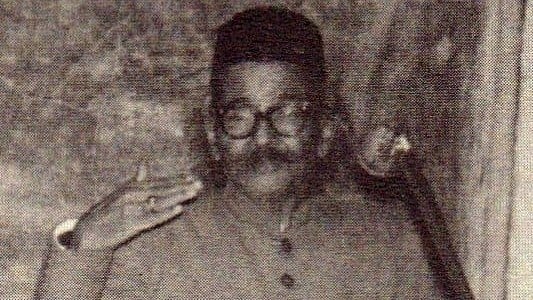
D R Bendre, popularly known as Da Ra Bendre.
Credit: DH Archives
Whenever I begin writing about Bendre’s poetry, a certain inhibition creeps into my thoughts. This hesitation is a natural response when discussing any contemporary poet. Placing a contemporary poet within a historical context is challenging; their poetry unfolds before our eyes, making it possible only to convey our immediate reactions.
The worth of such criticism lies in the value of that response. It is not to disregard the depth of appreciation some enthusiasts may have for contemporary poetry, as such engagement is not without merit. However, the true measure of a poem’s impact lies not merely in the admiration of a few but in its resonance with an entire nation. The cultivation of poetry is the cultivation of ‘Rasanubhava’ (experience of rasa), requiring time, as do life experiences.
Bendre is not only a contemporary poet but also one of the most significant voices of this era. His poetry exhibits a poetic richness not found in the works of old Kannada poets from Pampa to Muddana. This does not mean that the former is greater than the latter; rather, it reminds us of the necessity of seasonal variation in natural creation.
This diversity manifests through innovations in content, language, style and form. Such distinctions are readily apparent to a contemporary critic closely attuned to the nuances of poetry, who can comprehend these variations easily. Criticism is reflective of its time and encapsulates the prevailing tastes and poetic manners. Hence, concurrent engagement in contemporary criticism alongside poetry serves as a valuable guide for the succeeding generation of critics, fostering a deeper understanding of poetry.
Bendre belongs to the first generation of the inaugural phase of new Kannada poetry, known as the Navodaya period. Those who preceded him, such as B M Shri, Panje Mangeshrao and Hattiangadi Narayanarao, were all actively involved in forging a new poetic expression. Before Bendre’s Gari (Feather) was published, B M Shri’s English Gitegalu had already been published in 1926, while Govinda Pai was also exploring the avenues of innovative poetry.
‘English Gitegalu’ by B M Shri ‘Courtesy of Criticism: Selected Essays of Kirtinath Kurtkoti’ by Kamalakar Bhat and ‘Gari’ by Bendre.
However, these were harbingers of the new poetic form rather than its crystallisation, with distinct contours, beauty and aspirations not yet clearly discernible. Many of the experiments undertaken by Bendre under the banner of ‘Geleyara Gumpu’ (The Society of Friends) contributed significantly to the establishment of a new poetic tradition. Bendre’s resolve, encapsulated in the words ‘Mine is but a flower’s wish to leave some seeds behind’, has borne fruit beyond his initial expectations. Viewed from this perspective, Bendre’s persona exhibits a dual aspect — he was not only a poet but also a pioneer in shaping a poetic tradition.
The second of these tasks demands a unique set of skills. A tradition builder must harbour doubts about how far one can create great poetry by carefully observing both contemporary culture and the expressive ability of the language. Bendre’s poems, in and of themselves, constitute a wealth of poetry and embody various experiments in modern poetic forms. Innovation is not merely a transient process of transforming a new idea into a novel technique; instead, it involves revitalising primitive sentiments of the human heart with newfound significance across all facets of life.
In his early years, Bendre recognised that it is insufficient for a poet to construct their poetic idiom just once. His poetry accommodates a diverse range of poetic expressions, not attributable solely to versatility but rather indicative of poetic abundance. Only such rich poetry has the capacity to establish a tradition.
Dattatreya Ramachandra Bendre_ Popularly known as Da Raa Bendre_ He was one of the prominent Kannada poet _ He was awardred Gnana Peetha award the highest litarary honour_ Photo by DH/PV Staff Photographer Kannada eminent literature personalities.
Any study of Bendre’s poetry grapples with certain complexities. The evolution of his poetry is not a linear progression. Apart from a few poems composed before the publication of Gari (such as Kogile and Krishna Kumari), it becomes challenging to discern the stages of development in the remaining poems. This does not imply that his artistic persona was firmly rooted in Gari and did not evolve further.
The intricacy and enchantment of his poetic form conceal this development. Regardless of the specific poem examined, each resonates perfectly with the contemporary milieu. While he had previously penned romantic songs more poignant than Kuniyonu Bara (Come, Let Us Dance), when it was published, the emotional depth was unparalleled. The secret lies in the core of his poetry, where expression aligns seamlessly with its vital essence. Another complication arises from the poems’ lack of immediate understanding due to the absence of context.
The same observation can be expanded and discussed further. As mentioned earlier, Bendre’s poetic style assimilates influences from folk poetry, the songs of Anubhaava, the poetry of the ancients, Rabindranath Tagore, Aurobindo and numerous English poets, weaving them together in a surprising manner. It utilises all these influences to approach the subject of the poem. Hence, categorising his poetry becomes a challenging task.
The poem Belagu (Dawn) is not merely a description of the morning; the beauty of nature receives continuous enhancement in the poem with the creative process of the poem. Without it, the exclamation in one of the lines of the poem — ‘Idu bari belagallo, anna!’ (‘It is just dawn!’) seems a mechanical stanza, included to fulfil metrical requirements. Attempting to categorise Bendre’s poems thematically for critical assessment proves to be a complex task.
(This is an excerpt from ‘Courtesy and Criticism: Selected Essays of Kirtinath Kurtkoti’ edited and translated by Kamalakar Bhat)